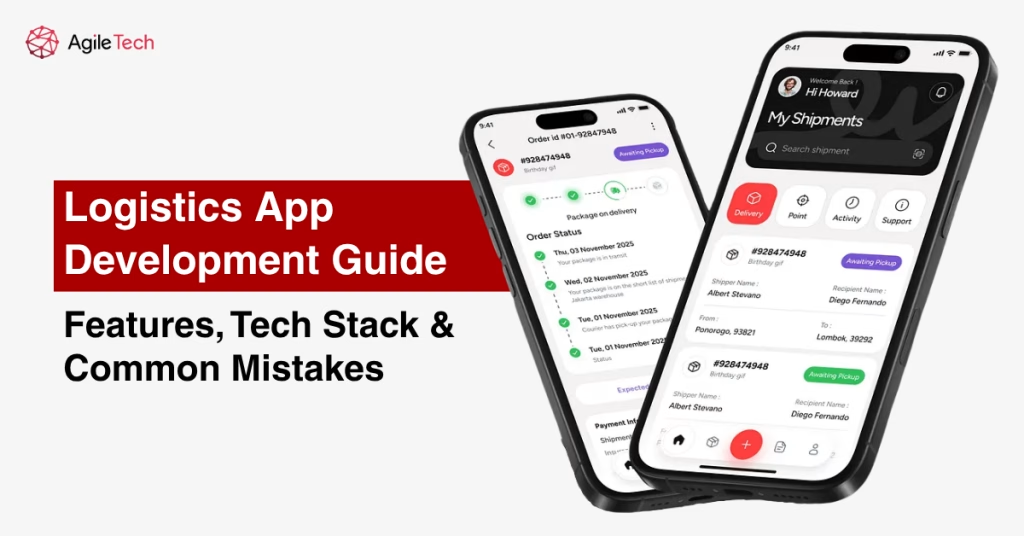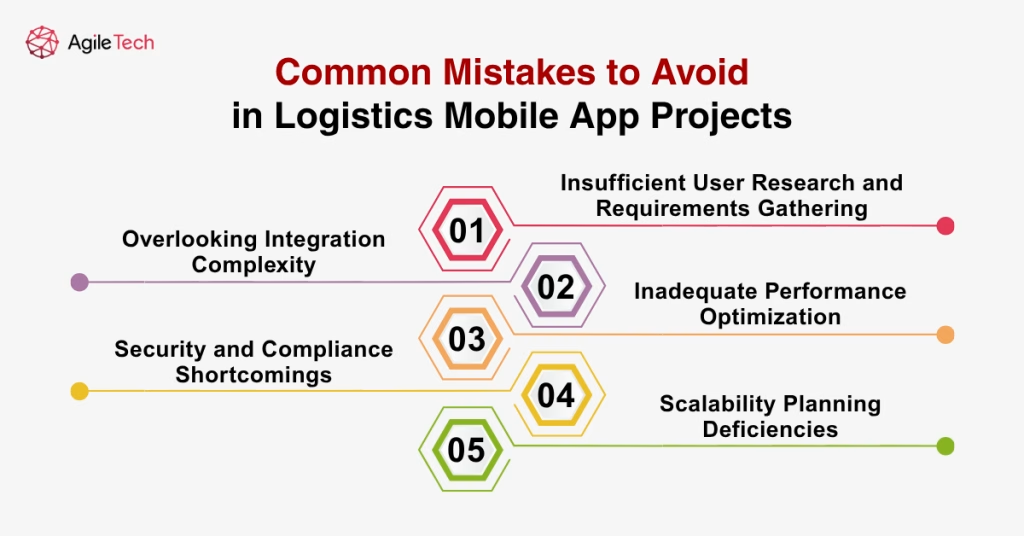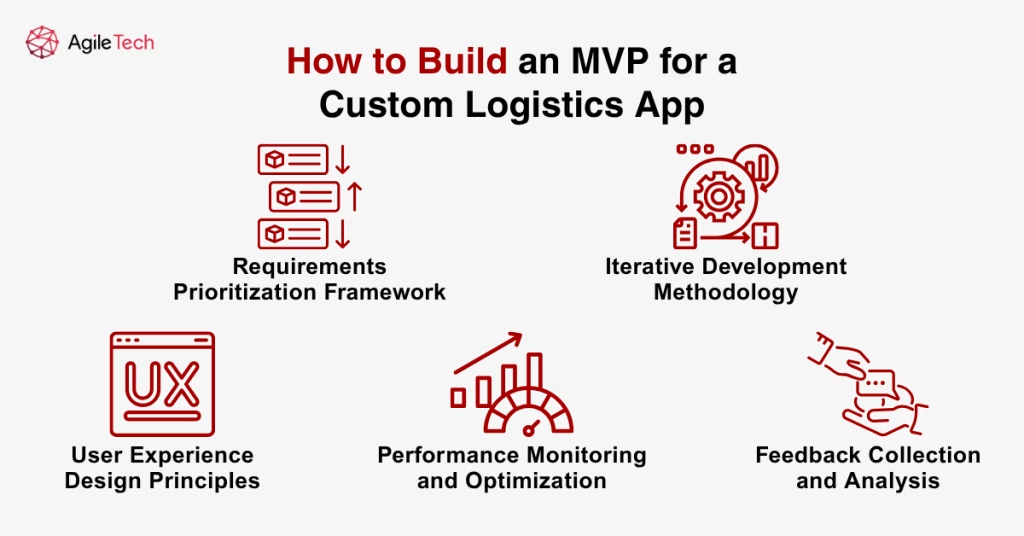Logistics App Development Guide: Features, Tech Stack & Common Mistakes
The logistics industry continues to undergo digital transformation, with companies increasingly turning to mobile technology to streamline operations, enhance visibility, and improve customer satisfaction. Modern logistics app development has become essential for businesses seeking to remain competitive in an increasingly complex supply chain environment. This comprehensive guide explores the critical aspects of building robust logistics mobile applications that deliver tangible business value.

- 1. Types of Logistics Apps
- 2. The Role of App Architecture in Efficient Logistics App Development
- 3. Common Mistakes to Avoid in Logistics Mobile App Projects
- 4. Key Features of a Modern Logistics Mobile App
- 5. Recommended Technology Stack for Logistics Application Development
- 6. Connecting Your Logistics App with Existing Systems
- 7. How to Build an MVP for a Custom Logistics App
- 8. Why AgileTech Is the Right Partner for Custom Logistics App Development
1. Types of Logistics Apps
1.1. Fleet Management Applications
Fleet management represents one of the most common categories in logistics app development. These applications focus on vehicle tracking, route optimization, and driver management. Companies utilize fleet management logistics mobile applications to monitor vehicle locations in real-time, analyze fuel consumption patterns, and ensure compliance with regulatory requirements. The integration of GPS technology and telematics data enables organizations to make informed decisions about vehicle deployment and maintenance scheduling.
1.2. Warehouse Management Systems
Warehouse-focused logistics applications streamline inventory operations through barcode scanning, stock level monitoring, and automated reordering processes. These systems integrate with existing enterprise resource planning platforms to provide comprehensive visibility into inventory movements. Modern warehouse management logistics mobile apps incorporate advanced features such as voice-directed picking, automated sorting algorithms, and predictive analytics for demand forecasting.
1.3. Supply Chain Visibility Platforms
Supply chain transparency has become increasingly important for businesses managing complex global operations. Logistics mobile applications in this category provide end-to-end visibility from raw material sourcing through final delivery. These platforms aggregate data from multiple sources, including suppliers, carriers, and distribution centers, to create comprehensive supply chain dashboards that enable proactive decision-making.
1.4. Last-Mile Delivery Solutions
The growth of e-commerce has intensified focus on last-mile delivery optimization. Custom logistics app development in this area typically includes route planning algorithms, delivery status updates, and customer communication features. These applications help logistics providers reduce delivery costs while improving customer experience through accurate delivery windows and real-time tracking capabilities.

2. The Role of App Architecture in Efficient Logistics App Development
Microservices Architecture Benefits
Modern logistics app development increasingly relies on microservices architecture to support scalable and maintainable applications. This architectural approach enables development teams to build modular systems where individual components can be updated, scaled, or replaced independently. For logistics mobile applications, microservices architecture provides flexibility to integrate with diverse third-party systems while maintaining system stability during high-traffic periods.
Cloud-Native Infrastructure Considerations
Cloud-native architecture has become the foundation for successful logistics application development. This approach leverages containerization, serverless computing, and managed database services to create resilient systems that can handle variable workloads. Logistics companies benefit from cloud-native architecture through improved scalability, reduced infrastructure management overhead, and enhanced disaster recovery capabilities.
API-First Development Strategy
Implementing an API-first development strategy ensures that logistics mobile apps can seamlessly integrate with existing enterprise systems and future technology additions. This approach involves designing robust application programming interfaces before building user interfaces, creating a solid foundation for system interoperability. API-first development particularly benefits logistics operations by enabling smooth data exchange between warehouse management systems, transportation management platforms, and customer-facing applications.
Data Architecture for Real-Time Processing
Logistics operations generate massive amounts of data that require real-time processing capabilities. Effective data architecture for logistics mobile applications incorporates streaming data platforms, in-memory databases, and event-driven processing systems. This infrastructure enables applications to provide instant updates on shipment status, inventory levels, and delivery exceptions while maintaining data consistency across distributed systems.
3. Common Mistakes to Avoid in Logistics Mobile App Projects
3.1. Insufficient User Research and Requirements Gathering
Many logistics app development projects fail due to an inadequate understanding of end-user needs and operational workflows. Development teams often underestimate the complexity of logistics operations and create applications that do not align with real-world usage patterns. Successful custom logistics app development requires extensive consultation with warehouse workers, drivers, dispatchers, and management personnel to understand their specific pain points and workflow requirements.
3.2. Overlooking Integration Complexity
Logistics organizations typically operate multiple legacy systems that must integrate with new mobile applications. Development teams frequently underestimate the complexity of connecting logistics mobile apps with existing enterprise resource planning systems, warehouse management platforms, and transportation management solutions. This oversight can lead to data silos, manual workarounds, and reduced operational efficiency.
3.3. Inadequate Performance Optimization
Logistics mobile applications often operate in challenging environments with limited connectivity and varying device capabilities. Common performance mistakes include insufficient offline functionality, poor data synchronization strategies, and inadequate optimization for low-bandwidth scenarios. These issues can severely impact productivity when logistics personnel rely on mobile applications in warehouses, distribution centers, and delivery vehicles.
3.4. Security and Compliance Shortcomings
Logistics operations involve sensitive information, including customer data, shipment details, and proprietary business processes. Development teams sometimes fail to implement adequate security measures, leaving applications vulnerable to data breaches and regulatory compliance violations. Proper security implementation requires encryption of data in transit and at rest, secure authentication mechanisms, and regular security auditing procedures.
3.5. Scalability Planning Deficiencies
Many logistics mobile app projects begin with limited user bases but must eventually support thousands of concurrent users across multiple geographic regions. Insufficient scalability planning can result in performance degradation, system outages, and expensive infrastructure redesigns. Successful logistics app development requires careful consideration of future growth scenarios and implementation of scalable architecture patterns from the initial development phase.

4. Key Features of a Modern Logistics Mobile App
4.1. Real-Time Tracking and Visibility
Contemporary logistics applications must provide comprehensive real-time tracking capabilities that enable users to monitor shipments, vehicles, and inventory throughout the supply chain. This functionality requires integration with GPS systems, RFID readers, and IoT sensors to collect location and status data continuously. Advanced tracking features include geofencing alerts, delivery confirmation capture, and automated status updates that keep all stakeholders informed without manual intervention.
4.2. Route Optimization and Planning
Intelligent route optimization represents a critical component of modern logistics mobile applications. These systems analyze multiple variables including traffic conditions, delivery windows, vehicle capacity, and driver availability to generate optimal routing solutions. Machine learning algorithms continuously improve route recommendations by analyzing historical performance data and identifying patterns that lead to more efficient operations.
4.3. Inventory Management Capabilities
Effective inventory management features enable logistics personnel to track stock levels, process receipts and shipments, and manage warehouse operations through mobile interfaces. Modern logistics applications incorporate barcode scanning, voice recognition, and automated data capture technologies to minimize manual data entry and reduce errors. Advanced inventory features include cycle counting support, exception reporting, and integration with demand planning systems.
4.4. Communication and Collaboration Tools
Logistics operations require constant communication between drivers, dispatchers, warehouse personnel, and customers. Modern logistics mobile apps include integrated messaging systems, document sharing capabilities, and collaboration features that streamline information exchange. These tools enable quick resolution of exceptions, efficient coordination of activities, and improved customer service through proactive communication.
4.5. Analytics and Reporting Functionality
Data-driven decision making has become essential for competitive logistics operations. Modern logistics applications include comprehensive analytics capabilities that provide insights into operational performance, cost optimization opportunities, and service quality metrics. Advanced reporting features enable users to create custom dashboards, schedule automated reports, and drill down into detailed performance data to identify improvement opportunities.

5. Recommended Technology Stack for Logistics Application Development
5.1. Frontend Development Technologies
React Native and Flutter have emerged as leading frameworks for cross-platform logistics mobile app development. These technologies enable development teams to create applications that run efficiently on both iOS and Android devices while sharing significant portions of the codebase. For web-based logistics applications, React.js and Angular provide robust frameworks that support complex user interfaces and real-time data visualization requirements.
5.2. Backend Infrastructure Components
Node.js and Python Django represent popular choices for backend development in logistics applications due to their scalability and extensive ecosystem support. These platforms provide excellent performance for handling concurrent requests and processing large datasets typical in logistics operations. Microservices architecture implemented with Docker containers and Kubernetes orchestration provides the flexibility and scalability required for modern logistics mobile applications.
5.3. Database Solutions for Logistics Data
Logistics applications typically require a combination of relational and NoSQL databases to handle diverse data types and access patterns. PostgreSQL provides excellent support for complex queries and spatial data processing required for location-based features. MongoDB and Cassandra offer advantages for handling large volumes of sensor data and providing fast read access for real-time tracking information. Redis serves as an effective caching layer to improve application performance and reduce database load.
5.4. Cloud Platform Integration
Amazon Web Services, Microsoft Azure, and Google Cloud Platform provide comprehensive infrastructure services that support scalable logistics app development. These platforms offer managed database services, serverless computing options, and machine learning capabilities that accelerate development while reducing operational complexity. Cloud-based infrastructure enables logistics applications to scale automatically based on demand and provides global availability for distributed operations.
5.5. Third-Party Service Integration
Modern logistics mobile applications rely on numerous third-party services for specialized functionality. Mapping and routing services from Google Maps, Mapbox, and Here Technologies provide essential location-based capabilities. Payment processing integration through Stripe or PayPal enables seamless transaction handling for cash-on-delivery and freight billing scenarios. Electronic logging device integration ensures compliance with transportation regulations while providing valuable operational data.
6. Connecting Your Logistics App with Existing Systems
6.1. Enterprise Resource Planning Integration
Successful logistics app development requires seamless integration with existing ERP systems to ensure data consistency and operational efficiency. This integration typically involves creating custom APIs that synchronize master data including customer information, product catalogs, and pricing structures. Modern integration approaches utilize middleware platforms such as MuleSoft or Apache Camel to manage complex data transformations and ensure reliable data exchange between systems.
For companies managing complex supply chain networks, it’s critical that your logistics mobile application integrates well with SCM systems. Learn more about SCM system software and its role in optimizing digital logistics infrastructure.
6.2. Warehouse Management System Connectivity
Logistics mobile applications must integrate closely with warehouse management systems to provide real-time inventory visibility and support mobile warehouse operations. This integration enables features such as mobile receiving, cycle counting, and pick-and-pack operations while maintaining data synchronization with core warehouse systems. API-based integration approaches provide the flexibility to support various WMS platforms while maintaining consistent application functionality.
6.3. Transportation Management Platform Links
Transportation management system integration enables logistics applications to access shipment planning, carrier selection, and freight audit capabilities. This connectivity supports features such as load optimization, carrier performance tracking, and automated freight billing processes. Modern TMS integration utilizes RESTful APIs and event-driven architectures to ensure real-time data exchange and support dynamic transportation planning requirements.
6.4. Customer Relationship Management Synchronization
CRM system integration ensures that logistics applications can access customer preferences, service history, and communication records to provide personalized service experiences. This integration enables features such as delivery preference management, service issue tracking, and proactive customer communication based on shipment status. Bidirectional data synchronization ensures that customer interactions captured through mobile applications are reflected in central CRM systems.
7. How to Build an MVP for a Custom Logistics App
7.1. Requirements Prioritization Framework
Developing a minimum viable product for logistics app development requires careful prioritization of features based on user value and technical complexity. The MoSCoW method (Must have, Should have, Could have, Won’t have) provides an effective framework for feature prioritization during MVP planning. Core functionality typically includes basic tracking capabilities, user authentication, and essential data capture features that address the most critical operational needs.
7.2. User Experience Design Principles
MVP development for logistics mobile applications should focus on creating intuitive user interfaces that minimize training requirements and support efficient task completion. This involves conducting user research with logistics personnel to understand their workflow patterns and designing interfaces that align with existing operational procedures. Responsive design principles ensure that applications function effectively across various device types and screen sizes commonly used in logistics environments.
7.3. Iterative Development Methodology
Agile development methodologies provide the flexibility needed for successful logistics app development projects. Sprint-based development cycles enable regular feedback collection from end users and allow for rapid iteration based on real-world usage patterns. Continuous integration and deployment practices ensure that new features can be delivered quickly while maintaining application stability and performance.
7.4. Performance Monitoring and Optimization
MVP development should include comprehensive performance monitoring capabilities to identify bottlenecks and optimization opportunities. Application performance monitoring tools provide insights into user behavior, system performance, and error patterns that inform future development priorities. Load testing and performance optimization ensure that applications can handle expected user volumes while maintaining responsive performance characteristics.
7.5. Feedback Collection and Analysis
Successful MVP development requires the systematic collection and analysis of user feedback to guide future feature development. In-app feedback mechanisms, user analytics, and regular stakeholder interviews provide valuable insights into application effectiveness and improvement opportunities. This feedback drives iterative development cycles that progressively enhance application functionality and user satisfaction.

8. Why AgileTech Is the Right Partner for Custom Logistics App Development
Proven Experience in Logistics Software Projects
AgileTech has delivered logistics mobile applications for startups and SMEs across Southeast Asia, Japan and Korea. From route optimization tools to integrated ERP platforms, our custom logistics app development services are proven and reliable.
A standout example is our development of a logistics CRM software solution for a delivery and transportation service. Within just three months, the platform helped the client reduce order processing time by 40%, increase customer retention by 25%, and support over 500+ daily active users across multiple operational roles. By centralizing customer data and automating order assignments, the solution significantly improved both backend efficiency and end-user experience.
Agile Development Process
We follow agile methodologies to deliver iterative improvements, fast MVP launches, and transparent progress reporting, ensuring you stay aligned with product goals.
Integration-First Mindset
Our logistics app development team specializes in integrating third-party APIs, CRM systems, GPS tracking platforms, and internal WMS or ERP tools with minimal disruption.
Dedicated Cross-Functional Team
From business analysts and UI/UX designers to backend developers and QA testers, our team is equipped to cover every aspect of your logistics mobile app lifecycle.
Focus on Scalability and Security
We build apps that grow with your business. With a focus on cloud-native development, secure architecture, and compliance with international standards, your logistics application is ready for enterprise-level demands.